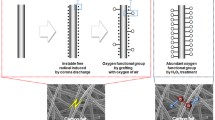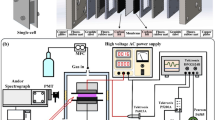Abstract
Vanadium redox flow batteries (VRFBs) are one of the most promising energy storage systems owing to their safety, efficiency, flexibility and scalability. However, the commercial viability of VRFBs is still hindered by the low electrochemical performance of the available carbon-based electrodes. Defect engineering is a powerful strategy to enhance the redox catalytic activity of carbon-based electrodes for VRFBs. In this paper, uniform carbon defects are introduced on the surfaces of carbon felt (CF) electrode by Ar plasma etching. Together with a higher specific surface area, the Ar plasma treated CF offers additional catalytic sites, allowing faster and more reversible oxidation/reduction reactions of vanadium ions. As a result, the VRFB using plasma treated electrode shows a power density of 1018.3 mW/cm2, an energy efficiency (EE) of 84.5%, and the EE remains stable over 1000 cycles.
摘要
钒氧化还原液流电池(钒液流电池)因其安全性、高效性、灵活性和可扩展性成为最有前途的储 能系统之一。然而,现有的碳基电极较低的电化学性能阻碍了钒液流电池的商业化应用,缺陷工程是 提高钒液流电池用碳基电极氧化还原催化活性的有效策略。本文采用氩气等离子体刻蚀法在碳毡电极 表面引入均匀的碳缺陷结构,使其具有更高的比表面积和额外的催化位点,促进了钒离子氧化还原反 应的可逆性。结果表明,采用等离子体处理碳毡电极的钒液流电池的功率密度提高到1018.3 mW/cm2, 能量效率为84.5%,且在1000次充放电循环后仍能保持稳定。
Similar content being viewed by others
References
YANG Xiao-fei, ZHANG Hong-zhang, CHEN Yu-qing, et al. Shapeable electrodes with extensive materials options and ultra-high loadings for energy storage devices [J]. Nano Energy, 2017, 39: 418–428. DOI: https://doi.org/10.1016/j.nanoen.2017.07.028.
LU Wen-jing, LI Xian-feng, ZHANG Hua-min. The next generation vanadium flow batteries with high power density—A perspective [J]. Physical Chemistry Chemical Physics: PCCP, 2017, 20(1): 23–35. DOI: https://doi.org/10.1039/c7cp07456e.
ZHENG Qiong, XING Feng, LI Xian-feng, et al. Flow field design and optimization based on the mass transport polarization regulation in a flow-through type vanadium flow battery [J]. Journal of Power Sources, 2016, 324: 402–411. DOI: https://doi.org/10.1016/j.jpowsour.2016.05.110.
YE Jia-ye, WU Chun, QIN Wei, et al. Advanced sulfonated poly(ether ether ketone)/graphene-oxide/titanium dioxide nanoparticle composited membrane with superior cyclability for vanadium redox flow battery [J]. Journal of Nanoscience and Nanotechnology, 2020, 20(8): 4714–4721. DOI: https://doi.org/10.1166/jnn.2020.18503.
LOU Xue-chun, YUAN Du, YU Yue-sheng, et al. A cost-effective nafion composite membrane as an effective vanadium-ion barrier for vanadium redox flow batteries [J]. Chemistry—An Asian Journal, 2020, 15(15): 2357–2363. DOI: https://doi.org/10.1002/asia.202000140.
YE Jia-ye, YUAN Du, DING Mei, et al. A cost-effective nafion/lignin composite membrane with low vanadium ion permeation for high performance vanadium redox flow battery [J]. Journal of Power Sources, 2021, 482: 229023. DOI: https://doi.org/10.1016/j.jpowsour.2020.229023.
HUANG Yu-qing, HUO Jia, DOU Shuo, et al. Graphitic C3N4 as a powerful catalyst for all-vanadium redox flow batteries [J]. RSC Advances, 2016, 6(70): 66368–66372. DOI: https://doi.org/10.1039/c6ra11381h.
XIA Lu, LONG Ting, LI Wen-yue, et al. Highly stable vanadium redox-flow battery assisted by redox-mediated catalysis [J]. Small, 2020, 16(38): e2003321. DOI: https://doi.org/10.1002/smll.202003321.
DAI Qing, LIU Zhi-qiang, HUANG Ling, et al. Thin-film composite membrane breaking the trade-off between conductivity and selectivity for a flow battery [J]. Nature Communications, 2020, 11: 13. DOI: https://doi.org/10.1038/s41467-019-13704-2.
LI Zhe-jun, LU Yi-chun. Material design of aqueous redox flow batteries: Fundamental challenges and mitigation strategies [J]. Advanced Materials, 2020, 32(47): 2002132. DOI: https://doi.org/10.1002/adma.202002132.
MEN Yue, SUN Ting. Carbon felts electrode treated in different weak acid solutions through electrochemical oxidation method for all vanadium redox flow battery [J]. International Journal of Electrochemical Science, 2012, 7(4): 3482–3488. DOI: https://doi.org/10.1016/j.jpowsour.2012.01.007.
PEZESHKI A M, CLEMENT J T, VEITH G M, et al. High performance electrodes in vanadium redox flow batteries through oxygen-enriched thermal activation [J]. Journal of Power Sources, 2015, 294: 333–338. DOI: https://doi.org/10.1016/j.jpowsour.2015.05.118.
LIU Tao, LI Xian-feng, XU Chi, et al. Activated carbon fiber paper based electrodes with high electrocatalytic activity for vanadium flow batteries with improved power density [J]. ACS Applied Materials & Interfaces, 2017, 9(5): 4626–4633. DOI: https://doi.org/10.1021/acsami.6b14478.
GREESE T, LOICHET TORRES P A, MENGA D, et al. Impact of plasma and thermal treatment on the long-term performance of vanadium redox flow electrodes-significance of surface structure vs oxygen functionalities [J]. Journal of the Electrochemical Society, 2021, 168(7): 070554. DOI: https://doi.org/10.1149/1945-7111/ac163e.
DIXON D, BABU D J, LANGNER J, et al. Effect of oxygen plasma treatment on the electrochemical performance of the rayon and polyacrylonitrile based carbon felt for the vanadium redox flow battery application [J]. Journal of Power Sources, 2016, 332: 240–248. DOI: https://doi.org/10.1016/j.jpowsour.2016.09.070.
KIM K J, KIM Y J, KIM J H, et al. The effects of surface modification on carbon felt electrodes for use in vanadium redox flow batteries [J]. Materials Chemistry and Physics, 2011, 131(1–2): 547–553. DOI: https://doi.org/10.1016/j.matchemphys.2011.10.022.
MEI Ting-ting, GAO Ming, LIU Dan-ni, et al. Enhanced electrocatalytic activity of carbon cloth by synergetic effect of plasma and acid treatment [J]. Plasma Science and Technology, 2021, 23(2): 025504. DOI: https://doi.org/10.1088/2058-6272/abd8b4.
TSENG T M, HUANG R H, HUANG C Y, et al. A kinetic study of the platinum/carbon anode catalyst for vanadium redox flow battery [J]. Journal of the Electrochemical Society A, 2013, 160(4): 690–696. DOI: https://doi.org/10.1149/2.073304jes.
WANG W H, WANG X D. Investigation of Ir-modified carbon felt as the positive electrode of an all-vanadium redox flow battery [J]. Electrochimica Acta, 2007, 52(24): 6755–6762. DOI: https://doi.org/10.1016/j.electacta.2007.04.121.
WEI L, ZHAO T S, ZENG L, et al. Copper nanoparticle-deposited graphite felt electrodes for all vanadium redox flow batteries [J]. Applied Energy, 2016, 180: 386–391. DOI: https://doi.org/10.1016/j.apenergy.2016.07.134.
LI Bin, GU Meng, NIE Zi-min, et al. Bismuth nanoparticle decorating graphite felt as a high-performance electrode for an all-vanadium redox flow battery [J]. Nano Letters, 2013, 13(3): 1330–1335. DOI: https://doi.org/10.1021/nl400223v.
LONG Ting, LONG Yong, DING Mei, et al. Large scale preparation of 20 cm × 20 cm graphene modified carbon felt for high performance vanadium redox flow battery [J]. Nano Research, 2021, 14(10): 3538–3544. DOI: https://doi.org/10.1007/s12274-021-3564-z.
XIANG Wei-zhe, XU Jian, ZHANG Yi-qiong, et al. A high-performance ammonia plasma-treated WO3 @carbon felt electrode for vanadium redox flow batteries [J]. Functional Materials Letters, 2021, 14(7): 2143009–2143013. DOI: https://doi.org/10.1142/s1793604721430098.
HA S, GALLAGHER K G. Estimating the system price of redox flow batteries for grid storage [J]. Journal of Power Sources, 2015, 296: 122–132. DOI: https://doi.org/10.1016/j.jpowsour.2015.07.004.
WANG Wei, LUO Qing-tao, LI Bin, et al. Recent progress in redox flow battery research and development [J]. Advanced Functional Materials, 2013, 23(8): 970–986. DOI: https://doi.org/10.1002/adfm.201200694.
DING Cong, ZHANG Hua-min, LI Xian-feng, et al. Vanadium flow battery for energy storage: Prospects and challenges [J]. The Journal of Physical Chemistry Letters, 2013, 4(8): 1281–1294. DOI: https://doi.org/10.1021/jz4001032.
ZHANG Yi-qiong, TAO Li, XIE Chao, et al. Defect engineering on electrode materials for rechargeable batteries [J]. Advanced Materials, 2020, 32(7): e1905923. DOI: https://doi.org/10.1002/adma.201905923.
ZHU Jia-wei, MU Shi-chun. Defect engineering in carbon-based electrocatalysts: Insight into intrinsic carbon defects [J]. Advanced Functional Materials, 2020, 30(25): 2001097. DOI: https://doi.org/10.1002/adfm.202001097.
HE Zhang-xing, JIANG Ying-qiao, MENG Wei, et al. HF/H2O2 treated graphite felt as the positive electrode for vanadium redox flow battery [J]. Applied Surface Science, 2017, 423: 111–118. DOI: https://doi.org/10.1016/j.apsusc.2017.06.154.
GAO Yu, WANG Hong-rui, MA Qiang, et al. Carbon sheet-decorated graphite felt electrode with high catalytic activity for vanadium redox flow batteries [J]. Carbon, 2019, 148: 9–15. DOI: https://doi.org/10.1016/j.carbon.2019.03.035.
LIU Zhi-juan, ZHAO Zheng-hang, WANG Yan-yong, et al. In situ exfoliated, edge-rich, oxygen-functionalized graphene from carbon fibers for oxygen electrocatalysis [J]. Advanced Materials, 2017, 29(18): 1606207. DOI: https://doi.org/10.1002/adma.201606207.
ZHANG Yi-qiong, XU Jian, LONG Yong, et al. Defect chemistry on electrode materials for electrochemical energy storage and conversion [J]. ChemNanoMat, 2020, 6(11): 1589–1600. DOI: https://doi.org/10.1002/cnma.202000437.
DIXON D, BABU D J, BHASKAR A, et al. Tuning the performance of vanadium redox flow batteries by modifying the structural defects of the carbon felt electrode [J]. Beilstein Journal of Nanotechnology, 2019, 10: 1698–1706. DOI: https://doi.org/10.3762/bjnano.10.165.
BLASI A D, BLASI O D, BRIGUGLIO N, et al. Investigation of several graphite-based electrodes for vanadium redox flow cell [J]. Journal of Power Sources, 2013, 227: 15–23. DOI: https://doi.org/10.1016/j.jpowsour.2012.10.098.
JIANG H R, SHYY W, ZENG L, et al. Highly efficient and ultra-stable boron-doped graphite felt electrodes for vanadium redox flow batteries [J]. Journal of Materials Chemistry A, 2018, 6(27): 13244–13253. DOI: https://doi.org/10.1039/c8ta03388a.
MUKHOPADHYAY A, YANG Yang, LI Yi-fan, et al. Mass transfer and reaction kinetic enhanced electrode for high-performance aqueous flow batteries [J]. Advanced Functional Materials, 2019, 29(43): 1903192. DOI: https://doi.org/10.1002/adfm.201903192.
FERRARI A C, BASKO D M. Raman spectroscopy as a versatile tool for studying the properties of graphene [J]. Nature Nanotechnology, 2013, 8(4): 235–246. DOI: https://doi.org/10.1038/nnano.2013.46.
HOSSEINI M G, MOUSAVIHASHEMI S, MURCIA-LÓPEZ S, et al. High-power positive electrode based on synergistic effect of N- and WO3-decorated carbon felt for vanadium redox flow batteries [J]. Carbon, 2018, 136: 444–453. DOI: https://doi.org/10.1016/j.carbon.2018.04.038.
LI Wen-yue, ZHANG Zhen-yu, TANG Yong-bing, et al. Graphene-nanowall-decorated carbon felt with excellent electrochemical activity toward \({\rm{VO}}_2^ + /{\rm{V}}{{\rm{O}}^{2 + }}\) couple for all vanadium redox flow battery [J]. Advanced Science, 2016, 3(4): 1500276. DOI: https://doi.org/10.1002/advs.201500276.
Author information
Authors and Affiliations
Contributions
JIA Chuan-kun conceived the experiment, obtained funding and provided resources. XU Jian conducted the main experiments, analyzed the measured data and wrote the draft. ZHANG Yi-qiong provided some experimental guides. ZHU Xiao-bo reviewed and edited the draft of the manuscript. LONG Ting processed some experimental data. XU He processed some data and conceived the schematic. LOU Xue-chun, XU Zhi-zhao, FU Hu and XIE Ming-ming performed some experiment and assisted in analyzing relevant data. XIANG Wei-zhe assisted in responding to the review comments.
Corresponding author
Additional information
Conflict of interest
XU Jian, ZHANG Yi-qiong, ZHU Xiao-bo, LONG Ting, XU He, LOU Xue-chun, XU Zhi-zhao, FU Hu, XIANG Wei-zhe, XIE Ming-ming, and JIA Chuan-kun declare that they have no conflict of interest.
Foundation item: Project(Xiang Zu [2016] 91) supported by the “100 Talented Teams” of Hunan Province, China; Project(2018RS3077) supported by the Huxiang High-level Talents Program, China; Project(22002009) supported by the National Natural Science Foundation of China; Project(2021JJ40565) supported by the Natural Science Foundation of Hunan Province, China; Project(19C0054) supported by the Scientific Research Foundation of Hunan Provincial Education Department, China
Rights and permissions
About this article
Cite this article
Xu, J., Zhang, Yq., Zhu, Xb. et al. Boosting catalytic activities of carbon felt electrode towards redox reactions of vanadium ions by defect engineering. J. Cent. South Univ. 29, 2956–2967 (2022). https://doi.org/10.1007/s11771-022-5129-z
Received:
Accepted:
Published:
Issue Date:
DOI: https://doi.org/10.1007/s11771-022-5129-z




